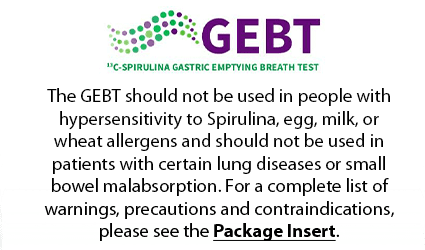- Cairn Diagnostic’s 13C-Spirulina Gastric Emptying Breath Test (GEBT) is the only FDA-approved breath test to aid in the definitive diagnosis of gastroparesis.
- Cairn Diagnostic’s 13C-Spirulina Gastric Emptying Breath Test (GEBT) was approved by the FDA in April 2015 for measuring the rate of gastric emptying of solids as an aid in the diagnosis of delayed gastric emptying (gastroparesis) in adults with symptoms of gastroparesis.
- The test system utilizes a Gas Isotope Ratio Mass Spectrometer (GIRMS) to measure the ratio of 13CO2 to 12CO2in breath samples.
- A health care professional should administer the GEBT, but no specialized facilities or specially licensed personnel are required.
GEBT vs. SCINTIGRAPHY
|
Cairn Diagnostics C13 Spirulina Gastric Emptying Breath Test (GEBT) |
Gastric Scintigraphy |
|
|---|---|---|
| Test meal and active ingredient |
|
|
| Data acquisition | To provide breath samples, patients blow through a straw into screwcapped tubes before ingesting the test meal and at intervals after finishing the test meal. | Gamma cameras take images in anterior and posterior positions. |
| Time intervals measured | 0 (pre-meal), 45, 90, 120, 150, 180, and 240 minutes | Typically 0, 60, 120, 240 minutes |
| Setting of care |
|
|
| Analysis and quantification of gastric emptying | The patient’s 13CO2 excretion rate is determined at each post-meal measurement time by gas isotope ratio mass spectrometry; the 13CO2 excretion rate is proportional to the amount of meal emptied from the stomach. | The amount of radiolabelled food emptied from/retained in stomach is measured at given time intervals. |
| Setting of analysis | Breath samples shipped to manufacturer’s CLIA lab for analysis (results typically available within 24 – 48 hours) | Analysis of radiolabel emptying conducted at imaging facility |
| Reporting of results |
|
|
| Diagnosis of gastroparesis | Clinician interprets kPCD values and graphic display of kPCD results compared to a normal reference range to determine diagnosis of gastroparesis. | Clinician interprets scint_FE and/or scint_t1/2 values compared with a normal reference range to determine diagnosis of gastroparesis. |
GEBT vs. SCINTIGRAPHY
- Cairn Diagnostic’s 13C-Spirulina Gastric Emptying Breath Test (GEBT) is the only FDA-approved breath test to aid in the definitive diagnosis of gastroparesis.
- Cairn Diagnostic’s 13C-Spirulina Gastric Emptying Breath Test (GEBT) was approved by the FDA in April 2015 for measuring the rate of gastric emptying of solids as an aid in the diagnosis of delayed gastric emptying (gastroparesis) in adults with symptoms of gastroparesis.
- The test system utilizes a Gas Isotope Ratio Mass Spectrometer (GIRMS) to measure the ratio of 13CO2 to 12CO2in breath samples.
- A health care professional should administer the GEBT, but no specialized facilities or specially licensed personnel are required.
|
Cairn Diagnostics C13 Spirulina Gastric Emptying Breath Test (GEBT) |
Gastric Scintigraphy |
|
|---|---|---|
| Test meal and active ingredient |
|
|
| Data acquisition | To provide breath samples, patients blow through a straw into screwcapped tubes before ingesting the test meal and at intervals after finishing the test meal. | Gamma cameras take images in anterior and posterior positions. |
| Time intervals measured | 0 (pre-meal), 45, 90, 120, 150, 180, and 240 minutes | Typically 0, 60, 120, 240 minutes |
| Setting of care |
|
|
| Analysis and quantification of gastric emptying | The patient’s 13CO2 excretion rate is determined at each post-meal measurement time by gas isotope ratio mass spectrometry; the 13CO2 excretion rate is proportional to the amount of meal emptied from the stomach. | The amount of radiolabelled food emptied from/retained in stomach is measured at given time intervals. |
| Setting of analysis | Breath samples shipped to manufacturer’s CLIA lab for analysis (results typically available within 24 – 48 hours) | Analysis of radiolabel emptying conducted at imaging facility |
| Reporting of results |
|
|
| Diagnosis of gastroparesis | Clinician interprets kPCD values and graphic display of kPCD results compared to a normal reference range to determine diagnosis of gastroparesis. | Clinician interprets scint_FE and/or scint_t1/2 values compared with a normal reference range to determine diagnosis of gastroparesis. |
Fill out the form below to start the conversation.




